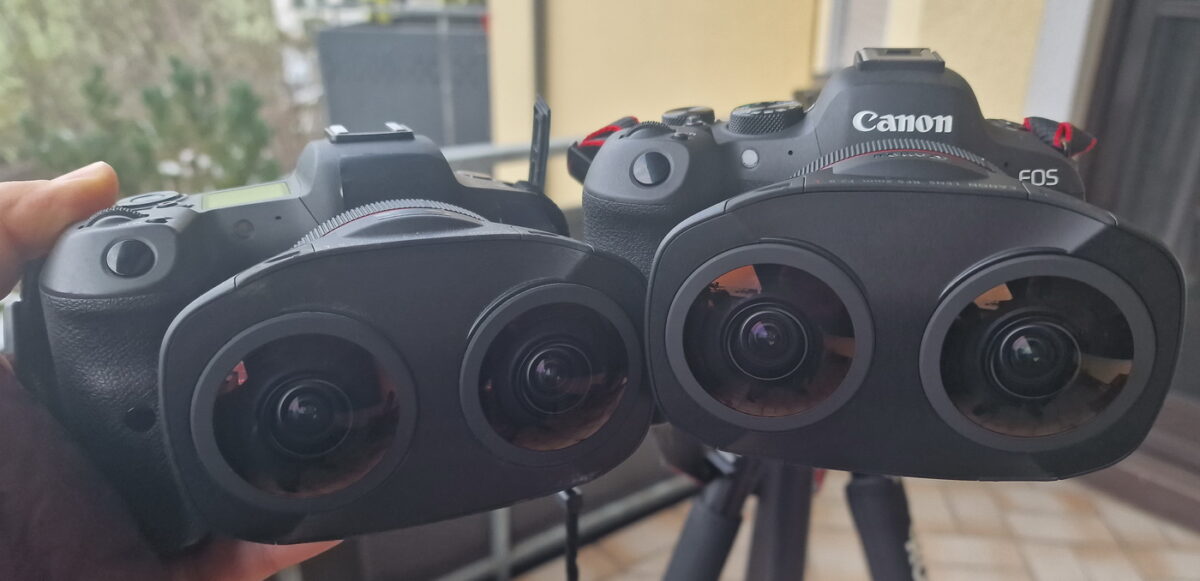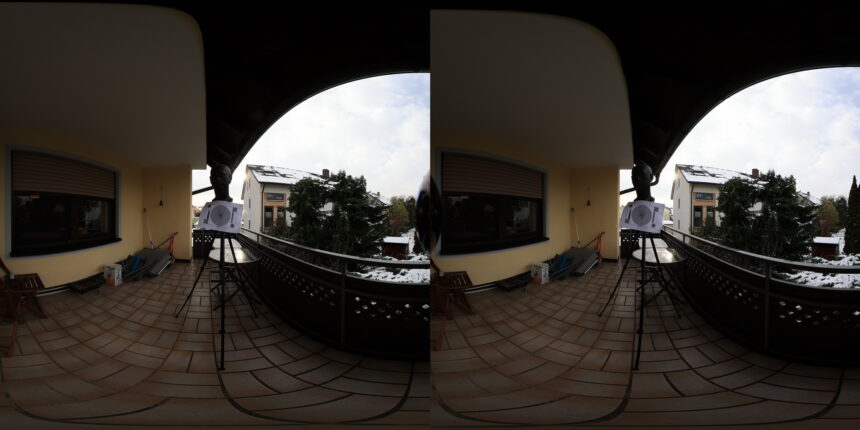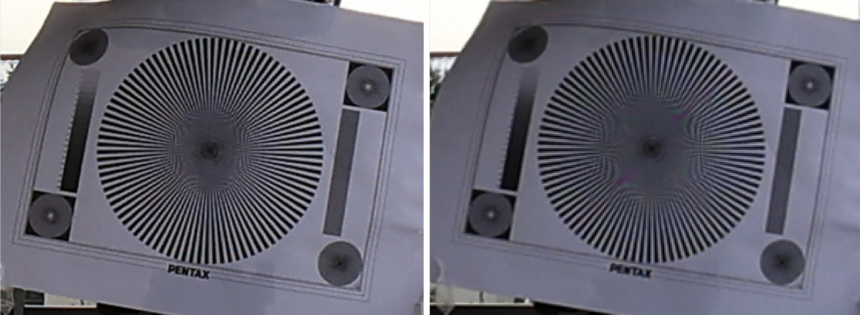Canon EOS R6 Mark II with VR180 Review: Cost-Effective EOS R5 Alternative at the Expense of Quality

How good is the Canon EOS R6 Mark II with VR180-3D lens for immersive photography and videography?
Canon has released a new firmware for the EOS R6 Mark II camera body with support for the Canon 5.2 mm VR180-3D lens. This is Canon's most affordable option for entering the world of immersive media capture. But can this variant keep up with the previous models?
I put it to the test.
Content
Review of Canon EOS R6 Mark II & 5.2 mm lens for VR180 in a nutshell
Canon has released a firmware update for the EOS R6 Mark II (Amazon) for use with the VR180 stereo lens RF 5.2mm F2.8L Dual Fisheye (Amazon). This allows immersive 3D media to be captured in 180°x180°. Compared to the already supported R5 (Amazon) and R5 C (Amazon) camera bodies, the slightly cheaper R6 Mark II offers a lower resolution. Based on comparison photos, we come to the conclusion that the savings when purchasing the camera body R6 Mark II are not worthwhile for a good VR experience.
Canon EOS R6 Mark II & 5.2 mm lens for VR180 are suitable for you if …
- you already own the EOS R6 Mark II and want to experiment with 3D and VR photography, and
- your focus is on recreational VR photography (6K) without video.
Canon EOS R6 Mark II & 5.2 mm lens for VR180 are less suitable for you if …
- you want to create VR videos (4K is not enough for VR), and
- you want the currently best possible VR180 quality for photos.
Canon’s VR180 story
At the beginning of 2021, Canon released the high-quality Canon RF 5.2 mm F2.8L Dual Fisheye lens, which can be used to create VR180-3D media. With two 190° fish eye lenses, which have approximately the average human eye distance, you can stereoscopically record a hemisphere in front of you. The generated image does not require stitching as with 360° panoramas.
However, the fish eye image or video is converted into an equirectangular format for compatibility. Just as the globe is projected onto a rectangular world map, the exact number of degrees on the (half) sphere is known for each pixel in the equirectangular format. This makes the media format manufacturer-independent and future-proof.
The reduction from 190° to 180° is not a problem, as the neighboring lens dominates the image at this angle anyway. In practice, 173° can therefore be used horizontally without visible lenses, which is normally not noticeable compared to 180°.
Canon’s camera body for VR180 in comparison
Until recently, either the EOS R5 (approx. $3,400) or EOS R5 C (approx. $3,800) camera body was required to use the Canon 5.2 mm lens. The models are almost identical, except that the R5 C has the image stabilizer removed and an additional fan installed. The R5 C can also record 8K @ 60 fps videos instead of 8K @ 30 fps.
If you also want to use the camera with other lenses for 2D, you might prefer the R5 because of the image stabilizer. If you are more focused on VR videos, the R5 C is the better choice. Together with the lens for approx. $1,800, the price would be approx. $5,200 or approx. $5,600. As there are occasional cash-back promotions on the camera bodies and also a bundle version of the R5 C and the VR180 lens, the price is somewhat lower in practice. However, it quickly becomes clear that the offer is aimed at professional users.
In November 2023, Canon unlocked another camera body for the 5.2 mm VR180 lens with a firmware update: the EOS R6 Mark II. In the following table, you will find a comparison of the three available camera bodies.
| EOS R5 | EOS R5 C | EOS R6 Mark II | |
| Release date | 07 / 2020 | 03 / 2022 | 11 / 2022 |
| Megapixel sensor | 45 | 45 | 24 |
| Photo resolution equirect | 8192 × 4096 | 8192 × 4096 | 6144 × 3072 |
| Video resolution equirect | 8192 × 4096 @ 30 fps | 8192 × 4096 @ 60 fps | 4096 × 2048 @ 60 fps |
| price | $3,400 | $3,800 | $2,300 |
As you can quickly see in the table, although the R6 Mark II is slightly cheaper than the EOS R5 and has 60 fps video, the photo resolution is 44 percent lower and the number of pixels in the video is only a quarter. Although the camera records videos internally with 6K oversampling thanks to the sensor, only 4K remains in the saved video at the end.
Based on this data, you have to ask yourself whether this is enough for a good experience in VR?
Review: EOS R5 vs. EOS R6 Mark II for VR180
I did the test and pitted the Canon EOS R5 against the R6 Mark II. First, I compare an outdoor shot that shows a detailed pattern. I'm looking at the converted images in equirectangular format, as these are ultimately also the format that you take in VR when viewing and are therefore more practical than a comparison of the stereo fish eye images.

VR180 outdoor test photo with the EOS R5 and the 5.2 mm VR180 lens.| Picture: Daniel Pohl
In comparison, the crop from the area of the test pattern:

Left: EOS R5. Right: EOS R6 Mark II. | Picture: Daniel Pohl
Not quite unexpectedly, the non-interpolated magnification shows that the left image of the EOS R5 shows more fine details towards the center of the circle before moiré effects appear, and the colors blur into shades of gray. The text under the circle is also clearer on the R5.
What is the effect of this in practice? Both cameras were used at the Nuremberg Christmas Market and captured the distant towers of St. Sebald's Church in the background of the picture. In addition to the photo mode, I also tested the video mode with 4K on the R6 Mark II.

Test photo VR180-3D in Nuremberg, Germany. | Picture: Daniel Pohl

Crop. Left: R5. Center: R6 Mark II photo. Right: R6 Mark II video screenshot.
On the left, we have the EOS R5 as a much sharper camera with 8K photo resolution. In the middle is the image with less detail due to the lower 6K resolution of the R6 Mark II. From a screenshot of the 4K video of the R6 Mark II, you can see that this resolution with only a quarter of the pixels compared to the R5 only makes limited sense. The slight color variance between the images is due to a different automatic white balance, which should ideally be set manually beforehand for capturing photos with snow.
R6 Mark II: No purchase recommendation as a pure VR camera
The differences in resolution between the EOS R5 and the R6 Mark II already gave us an idea: the same sharpness is not achieved. Without falling into a megapixel craze, we know that this is not the only criterion that counts for camera sensors, but also the size, quality, and noise behavior. Both the R5 and the R6 Mark II have very good sensors overall, which can produce high-quality media.
For virtual reality, where our stereo image is distributed over a 180°x180° hemisphere, the R6 Mark II with 24 megapixels for photos has not yet exceeded the threshold at which pure resolution would no longer be the dominant factor in image quality. Not to mention the 4K video resolution, despite internal oversampling with 6K.
This is content that will not advance VR and immersive media. The price saving of the R6 Mark II camera body, which is around 33 percent cheaper than the R5, unfortunately comes at the cost of a massive loss of sharpness. Only content creators who already have an R6 Mark II and want to get a taste of VR have the opportunity to take relatively good 6K photos for the available resolution in the VR photo area. They clearly outperform older 6K consumer VR180 cameras such as the Lenovo Mirage Camera or the Insta360 EVO. Canon's move to explicitly support the R6 Mark II model for the VR180 lens therefore comes as something of a surprise to me. Perhaps internally it was more about generalizing the firmware features for the support of the 5.2 mm lens so that they can also be easily supported by other, future camera bodies with higher resolution.
According to Canonrumors.com, the EOS R5 Mark II will be presented in Q1/2024. Although no firm data is known yet, there is speculation of a 62-megapixel sensor, which would offer 38 percent more pixels than the current R5. This would also have a positive effect when viewing such immersive media on devices such as the Meta Quest 3.
There have also been rumors of a 100+ megapixel camera from Canon for years. Unfortunately, concrete details are scarce. However, these images could also offer a significantly more immersive experience on the Quest 3 and even more so on higher-resolution HMDs such as the Apple Vision Pro. Something significant is also happening in the consumer sector of VR180 cameras: Canon wants to offer a foldable VR180-3D / 360-2D camera that can take photos at 8K and videos at 8K @ 30 fps. With an estimated price of under $1,000, this could become the camera model of choice for capturing immersive media.
Disclaimer: We received the EOS R6 Mark II with the 5.2 mm VR180 lens from Canon Europe.
The author, Daniel Pohl, is CEO and founder of immerVR GmbH. There, Daniel works daily on innovations in the field of immersive media, mostly in the area of VR180 stereo photography. With his app immerGallery, you can experience immersive photo galleries with voice-overs and background music in various VR formats on Meta Quest headsets.
Note: Links to online stores in articles can be so-called affiliate links. If you buy through this link, MIXED receives a commission from the provider. For you the price does not change.